9 用户模块开发
Posted 姜腾腾
tags:
篇首语:本文由小常识网(cha138.com)小编为大家整理,主要介绍了9 用户模块开发相关的知识,希望对你有一定的参考价值。
本小节,我们来完成最后一个模块--用户模块的开发。
用户模块一共有5个页面,分别是登录页面,注册页面,用户操作页面,收藏职位页面以及投递记录页面,先在src/view/目录下,创建这五个页面的视图文件login.html,register.html,my.html,favorite.html,post.html。
然后给视图添加路由,打开router.js文件:
.state(\'login\',{ url:\'/login\', templateUrl:\'view/login.html\', controller:\'loginCtrl\' }) .state(\'register\',{ url:\'/register\', templateUrl:\'view/register.html\', controller:\'registerCtrl\' }) .state(\'my\',{ url:\'/my\', templateUrl:\'view/my.html\', controller:\'myCtrl\' }) .state(\'favorite\',{ url:\'/favorite\', templateUrl:\'view/favorite.html\', controller:\'favoriteCtrl\' }) .state(\'post\',{ url:\'/post\', templateUrl:\'view/post.html\', controller:\'postCtrl\' });
然后给这五个页面分别创建5个controller,进入src/script/controller/目录下,新建文件loginCtrl.js,registerCtrl.js,myCtrl.js,favoriteCtrl.js,postCtrl.js,分别写入内容:
\'use strict\'; angular.module(\'app\') .controller(\'loginCtrl\',[\'$http\', \'$scope\', function ($http, $scope) { }]);
(这五个控制器的代码基本相同,只是控制器的名字不同,大家可以手动改一下,这里我只贴一个控制器的代码了)
我们先来完成登录页面,打开login.html文件:
<div class="login"> <form class="d-b ta-c"> <div class="form-line ta-l"> <span class="account va-m d-ib"></span> <input class="d-ib" type="text" placeholder="输入手机号"> </div> <div class="form-line ta-l"> <span class="lock va-m d-ib"></span> <input class="d-ib" type="text" placeholder="输入密码"> </div> <button class="login-btn">登录</button> <button class="register-btn">注册</button> </form> </div>
在src/style/目录下创建login.less文件并引入index.less文件添加样式后,登录页面如下:
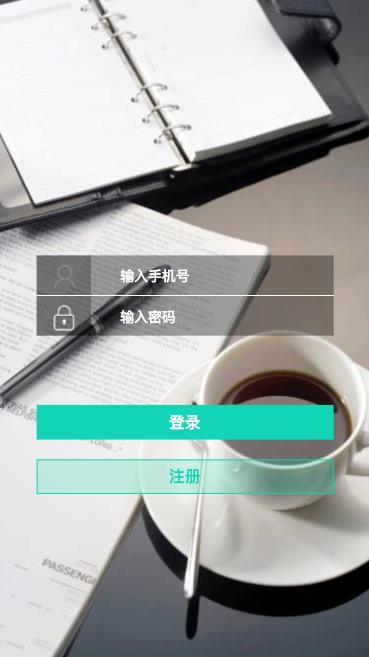
下面我们来开发注册静态页面,打开register.html文件:
<div class="register"> <form class="d-b ta-c"> <div class="form-line ta-l"> <span class="account va-m d-ib"></span> <input class="d-ib" type="text" placeholder="输入手机号"> </div> <div class="form-line ta-l"> <span class="lock va-m d-ib"></span> <input class="d-ib" type="text" placeholder="设置6位以上的密码"> </div> <div class="msgwrap ta-l"> <input class="msgbox" type="text" placeholder="短信验证码"> <span class="msg f-r">发送短信</span> </div> <button class="login-btn">登录</button> <button class="register-btn">注册</button> </form> </div>
在src/style/目录下创建register.less文件并引入index.less文件添加样式后,登录页面如下:
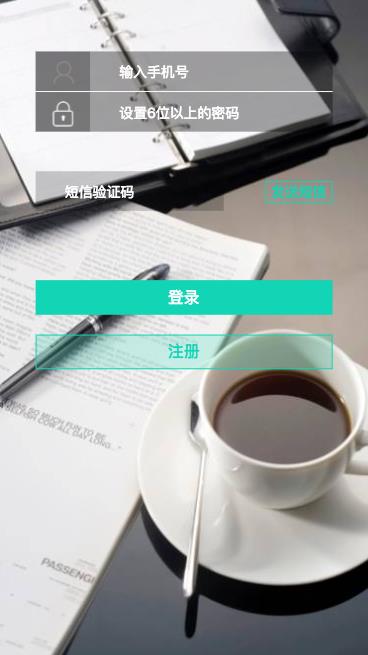
下面我们来开发第三个页面我的操作页面,打开my.html:
<div class="my ta-c"> <img class="d-b" src="image/head.png"> <div class="name">小胖儿</div> <div class="btns"> <button>投递</button> <button>收藏</button> <button class="logout">退出登录</button> </div> </div> <div app-foot></div>
在src/style/目录下创建my.less文件并引入index.less文件添加样式后,登录页面如下:

第四个和第五个页面,分别是投递记录和收藏页面,它俩的入口都是my.html,我们先来修改一下my.html文件:
<button ui-sref="favorite">收藏</button> <button class="logout">退出登录</button>
然后进入收藏页面favorite.html:
<div app-head-bar text="我的收藏"></div> <div app-position-list></div>
页面如下所示,暂时没有职位列表的内容:

下面是投递记录页面,打开post.html文件:
<div app-head-bar text="投递记录"></div> <div app-tab list="tabList"></div> <div app-position-list></div>
然后打开postCtrl.js文件,给app-tab添加数据接口:
\'use strict\'; angular.module(\'app\') .controller(\'postCtrl\',[\'$http\', \'$scope\', function ($http, $scope) { $scope.tabList = [{ id:\'all\', name:\'全部\' },{ id:\'pass\', name:\'面试邀请\' },{ id:\'fail\', name:\'不合适\' }]; }]);
现在我们可以看到投递记录的页面如下所示:
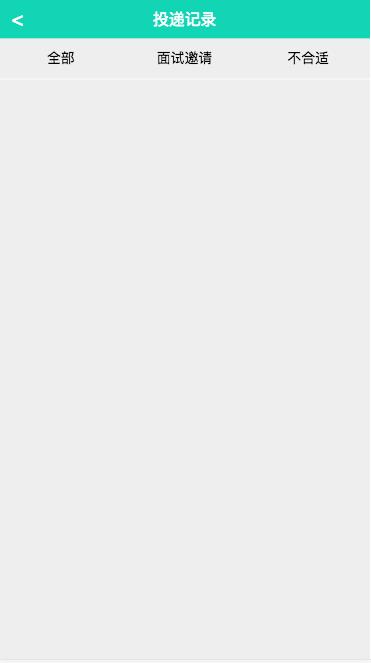
现在,用户模块的五个静态页面都已经开发完了,我们开始编写用户模块的逻辑。
先写注册页面的业务逻辑,在开发这部分的逻辑之前,我们先来安装一个angular的验证表单的插件和cookie模块,打开终端,进入项目目录,执行命令:
$ bower install --save angular-validation
安装完成后会提示安装的版本号
$ bower install --save angular-cookies
安装完成后会显示版本号
将安装的插件引入到index.html文件中:
<script src="vendor/angular-cookies/angular-cookies.min.js"></script>
<script src="vendor/angular-validation/dist/angular-validation.min.js"></script>
同时在app.js文件中,声明对validation模块的依赖:
angular.module(\'app\',[\'ui.router\',\'ngCookies\', \'validation\']);
新建文件:cache.js在src/script/service/目录下:
\'use strict\'; angular.module(\'app\').service(\'cache\', [\'$cookies\', function($cookies){ this.put = function(key,value){ $cookies.put(key,value); }; this.get = function(key){ return $cookies.get(key); }; this.remove = function(key){ return $cookies.remove(key); }; }]);
在src/script/config/目录下创建validation.js文件用来表单校验:
\'use strict\'; angular.module(\'app\').config([\'$validationProvider\', function($validationProvider){ var expression = { phone:/^1[\\d]{10}$/, password:function(value){ var str = value+\'\';
return str.length > 5; },
required:function(value){
return !!value;
} }; var defaultMsg = { phone:{ success:\'\', error:\'必须为11位手机号\' }, password:{ success:\'\', error:\'长度至少6位\' },
required:{
success:\'\',
error:\'不能为空\'
} }; $validationProvider.setExpression(expression).setDefaultMsg(defaultMsg); }]);
打开register.html文件,引入我们编写好的校验逻辑:
<div class="register"> <form class="d-b ta-c" name="form"> <div class="form-line ta-l"> <span class="account va-m d-ib"></span> <input name="phone" ng-model="user.phone" validator="required,phone" class="d-ib" type="text" placeholder="输入手机号"> </div> <div class="form-line ta-l"> <span class="lock va-m d-ib"></span> <input name="password" ng-model="user.password" validator="required,password" class="d-ib" type="text" placeholder="设置6位以上的密码"> </div> <div class="msgwrap ta-l"> <input name="code" validator="required" class="msgbox" type="text" placeholder="短信验证码"> <span class="msg f-r">发送短信</span> </div> <button class="login-btn">登录</button> <button class="register-btn" validation-submit="form" ng-click="submit()">注册</button> </form> </div>
但是我们发现,当我们在注册页面电话号码的位置输入非数字时,没有报错也没有提示信息,控制台选中表单元素,我们可以看到提示信息已经有了,放在一个span标签里:

但是我们的页面没有显示,当修改调整样式后,我们可以看到提示信息出现在了我们期望的位置如下:
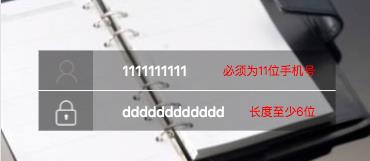
当我们点击注册的时候,调用submit()函数,打开register.js文件,添加点击事件的方法:
\'use strict\'; angular.module(\'app\') .controller(\'registerCtrl\',[\'$http\', \'$scope\', function ($http, $scope) { $scope.submit = function(){ console.log($scope.user); }; }]);
这时,我们输入的手机号和密码通过验证了,点击注册,控制台会打印出电话号码和密码。
下面我们来完成验证码部分的逻辑。修改register.html代码:
<div class="msgwrap ta-l"> <input validator="required" ng-model="user.code" class="msgbox" type="text" placeholder="短信验证码"> <span ng-click="time?1==1:send();" ng-bind="time?time:\'发送短信\'" class="{{time?\'disabled\':\'\'}} msg f-r"></span> </div>
然后打开register.js文件编写send()函数:
\'use strict\'; angular.module(\'app\') .controller(\'registerCtrl\',[\'$interval\', \'$http\', \'$scope\', function ($interval, $http, $scope) { $scope.submit = function(){ console.log($scope.user); }; var count = 60; $scope.send = function(){ $http.get(\'/data/code.json\').success(function(resp){ if(resp.state===1){ count = 60; $scope.time = \'60s\'; var interval = $interval(function(){ if(count<=0){ $interval.cancel(interval); $scope.time =\'\'; return; }else{ count--; $scope.time = count+\'s\'; } },1000); } }) }; }]);
这样我们就实现了,点击发送短信,变成灰色倒计时的效果了:

还要记得改一下登录按钮的跳转指向 打开register.html:
<button class="login-btn" ui-sref="login">登录</button>
下面我们要用装饰器,将一个post请求改为一个get请求,因为我们短信验证没有实际后台,所以这里我们使用这种方法,新建文件src/script/config/http.js:
\'use strict\'; angular.module(\'app\').config([\'$provide\',function($provide) { $provide.decorator(\'$http\', [\'$delegate\', \'$q\', function($delegate, $q){ var get = $delegate.get; $delegate.post = function(url, data, config){ var def = $q.defer(); get(url).success(function(resp){ def.resolve(resp); }).error(function(){ def.reject(resp); }) return { success:function(cb){ def.promise.then(cb); }, error:function(cb){ def.promise.then(null, cb); } } } return $delegate; }]); }]);
然后打开register.js文件,修改我们的submit()函数:
\'use strict\'; angular.module(\'app\') .controller(\'registerCtrl\',[\'$interval\', \'$http\', \'$scope\',\'$state\', function ($interval, $http, $scope, $state) { $scope.submit = function(){ //console.log($scope.user); $http.post(\'/data/regist.json\', $scope.user).success(function(resp){ // console.log(resp); $state.go(\'login\'); }); };
现在,我们在注册页面填写注册信息后,点击注册就可以跳转到登录页面了:
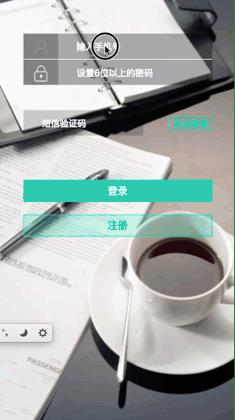
注册页面的业务逻辑我们已经完成了,下面完成登录页面的逻辑。
进入登录页面模板login.html:
<div class="login"> <form class="d-b ta-c" name="form"> <div class="form-line ta-l"> <span class="account va-m d-ib"></span> <input name="phone" validator="required,phone" ng-model="user.phone" class="d-ib" type="text" placeholder="输入手机号"> </div> <div class="form-line ta-l"> <span class="lock va-m d-ib"></span> <input name="password" validator="required,password" ng-model="user.password" class="d-ib" type="password" placeholder="输入密码"> </div> <button class="login-btn" validation-submit="form" ng-click="submit()">登录</button> <button class="register-btn" ui-sref="register">注册</button> </form> </div>
然后修改登录的控制器文件loginCtrl.js:
\'use strict\'; angular.module(\'app\') .controller(\'loginCtrl\',[\'cache\', \'$http\', \'$scope\', \'$state\', function (cache, $http, $scope, $state) { $scope.submit = function(){ $http.post(\'/data/login.json\', $scope.user).success(function(resp){ cache.put(\'id\', resp.id); cache.put(\'name\', resp.name); cache.put(\'image\', resp.image); $state.go(\'main\'); }) } }]);
现在我们来修改登录后我的页面的逻辑,先修改视图代码my.html:
<div class="my ta-c"> <div ng-if="name"> <img class="d-b" ng-src="{{image}}"> <div class="name" ng-bind="name"></div> <div class="btns"> <button ui-sref="post">投递</button> <button ui-sref="favorite">收藏</button> <button class="logout" ng-click="logout()">退出登录</button> </div> </div> <div ng-hide="name" ui-sref="login"> <button class="login-btn">去登录</button> </div> </div> <div app-foot></div>
然后修改my部分的逻辑,打开myCtrl.js文件:
\'use strict\'; angular.module(\'app\') .controller(\'myCtrl\',[\'$state\', \'cache\', \'$http\', \'$scope\', function ($state, cache, $http, $scope) { if(cache.get(\'name\')){ $scope.name = cache.get(\'name\'); $scope.image = cache.get(\'image\'); }; $scope.logout = function(){ cache.remove(\'id\'); cache.remove(\'name\'); cache.remove(\'image\'); $state.go(\'main\'); }; }]);
我的页面退出登录的逻辑我们在上面已经完成了,现在还剩下投递和收藏两个功能,先来完成投递功能,打开post.html:
<div app-head-bar text="投递记录"></div> <div app-tab list="tabList" tab-click="tClick(id,name)"></div> <div app-position-list data="positionList" class="my-post" filter-obj="filterObj"></div>
然后打开post.js文件添加逻辑:
\'use strict\'; angular.module(\'app\') .controller(\'postCtrl\', [\'$http\', \'$scope\', function($http, $scope) { $scope.tabList = [{ id: \'all\', name: \'全部\' }, { id: \'pass\', name: \'面试邀请\' }, { id: \'fail\', name: \'不合适\' }]; $http.get(\'data/myPost.json\').success(function(resp) { $scope.positionList = resp; }); $scope.filterObj = {}; $scope.tClick = function(id, name) { switch (id) { case \'all\': delete $scope.filterObj.state; break; case \'pass\': $scope.filterObj.state = "1"; break; case \'fail\': $scope.filterObj.state = "-1"; break; default: } }; }]);
现在就剩下最后一个功能啦--收藏功能,因为已经收藏的职位,我们先让收藏页面可以显示出来收藏列表,打开favorite.html文件:
<div app-head-bar text="我的收藏"></div> <div app-position-list data="list"></div>
然后打开favoriteCtrl.js文件:
\'use strict\'; angular.module(\'app\') .controller(\'favoriteCtrl\',[\'$http\', \'$scope\', function ($http, $scope) { $http.get(\'data/myFavorite.json\').success(function(resp){ $scope.list = resp; }); }]);
此时已经可以显示出来收藏列表了:

但是我们希望的是,在每项收藏的职位后面,都有一个五角星来显示页面的收藏选项的功能,要实现这个功能,我们需要修改职位列表页面以及其逻辑,打开positionlist.html文件:
<ul class="position-list bg-w"> <li ui-sref="position({id:item.id})" class="item p-r" ng-repeat="item in data|filterByObj:filterObj"> <img class="f-l logo" ng-src="{{item.imageUrl}}" alt=""> <h3 class="title" ng-bind="item.job+\' \'+item.salaryName"></h3> <p class="text" ng-bind="item.companyName+\'(\'+item.cityName+\')\'+item.industryName+\' \'+item.scaleName"></p> <p class="text" ng-bind="item.date"></p> <span ng-click="$event.stopPropagation();select(item)" ng-if="name" class="p-a icon {{item.select?\'star-active\':\'star\'}}"></span> <div class="clear"></div> </li> </ul>
然后打开positionlist.js文件:
\'use strict\'; angular.module(\'app\').directive(\'appPositionList\',[\'cache\',\'$http\', f以上是关于9 用户模块开发的主要内容,如果未能解决你的问题,请参考以下文章